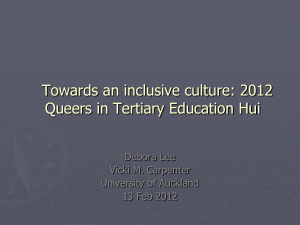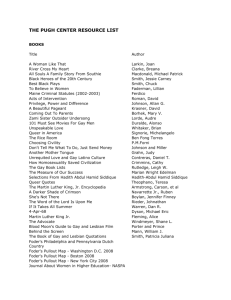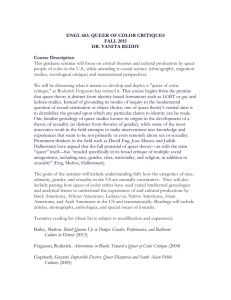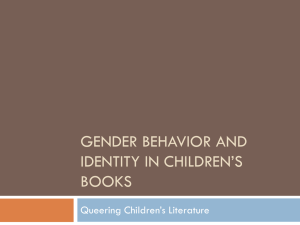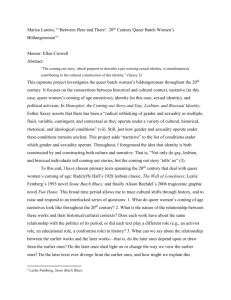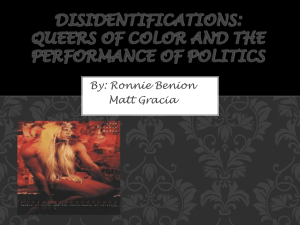Chapter 5
advertisement
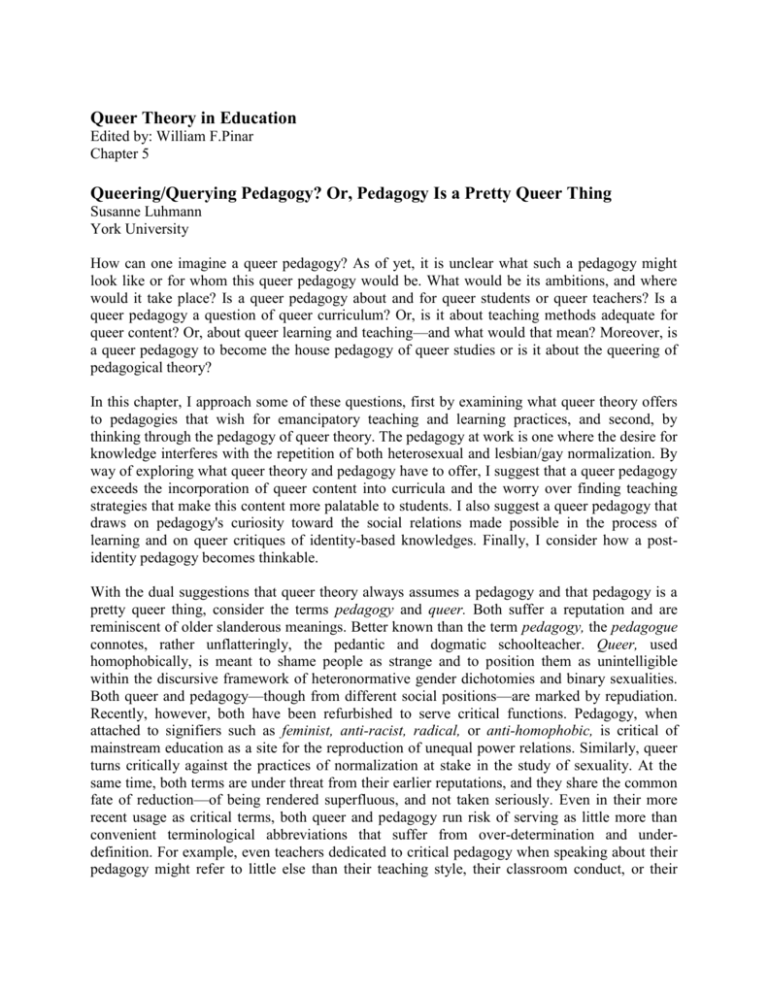
Queer Theory in Education Edited by: William F.Pinar Chapter 5 Queering/Querying Pedagogy? Or, Pedagogy Is a Pretty Queer Thing Susanne Luhmann York University How can one imagine a queer pedagogy? As of yet, it is unclear what such a pedagogy might look like or for whom this queer pedagogy would be. What would be its ambitions, and where would it take place? Is a queer pedagogy about and for queer students or queer teachers? Is a queer pedagogy a question of queer curriculum? Or, is it about teaching methods adequate for queer content? Or, about queer learning and teaching—and what would that mean? Moreover, is a queer pedagogy to become the house pedagogy of queer studies or is it about the queering of pedagogical theory? In this chapter, I approach some of these questions, first by examining what queer theory offers to pedagogies that wish for emancipatory teaching and learning practices, and second, by thinking through the pedagogy of queer theory. The pedagogy at work is one where the desire for knowledge interferes with the repetition of both heterosexual and lesbian/gay normalization. By way of exploring what queer theory and pedagogy have to offer, I suggest that a queer pedagogy exceeds the incorporation of queer content into curricula and the worry over finding teaching strategies that make this content more palatable to students. I also suggest a queer pedagogy that draws on pedagogy's curiosity toward the social relations made possible in the process of learning and on queer critiques of identity-based knowledges. Finally, I consider how a postidentity pedagogy becomes thinkable. With the dual suggestions that queer theory always assumes a pedagogy and that pedagogy is a pretty queer thing, consider the terms pedagogy and queer. Both suffer a reputation and are reminiscent of older slanderous meanings. Better known than the term pedagogy, the pedagogue connotes, rather unflatteringly, the pedantic and dogmatic schoolteacher. Queer, used homophobically, is meant to shame people as strange and to position them as unintelligible within the discursive framework of heteronormative gender dichotomies and binary sexualities. Both queer and pedagogy—though from different social positions—are marked by repudiation. Recently, however, both have been refurbished to serve critical functions. Pedagogy, when attached to signifiers such as feminist, anti-racist, radical, or anti-homophobic, is critical of mainstream education as a site for the reproduction of unequal power relations. Similarly, queer turns critically against the practices of normalization at stake in the study of sexuality. At the same time, both terms are under threat from their earlier reputations, and they share the common fate of reduction—of being rendered superfluous, and not taken seriously. Even in their more recent usage as critical terms, both queer and pedagogy run risk of serving as little more than convenient terminological abbreviations that suffer from over-determination and underdefinition. For example, even teachers dedicated to critical pedagogy when speaking about their pedagogy might refer to little else than their teaching style, their classroom conduct, or their preferred teaching methods. In similar fashion, even in queer circles queer is often used as a mere alternative, or more convenient short-form to the lengthy "lesbian, gay, bisexual, transgendered, and transsexual." There may, however, be more substantial issues at stake in the desires of radical pedagogies and queer theories. In spite of their intentions to serve as forms of critical or subversive intervention in oppressive classroom relations, heteronormative sexualities and gender regimes, respectively, with their confident claims of subversion and provocative interference with the production of normalcy, risk overlooking the normalization at stake in their own practices. Although the direction of my argument is to think about interventions in normalcy, I have grown more cautious, and now worry about the limits of subversive practices. Accordingly, I suggest that a queer pedagogy must learn to be self-reflective of its own limitations. Queering Pedagogy: or, What Happens When Queer Theory is Brought to Bear on Pedagogy? Immense moral panics erupt over the discovery that lesbians and gays educate our children. Intense, sometimes even violent, contestations occur over the curricular inclusion of the study of sexuality in general, and of lesbian and gay content in particular. For many, this is at once evidence of the repressed state of sexuality within the realm of education and of the marginalization of lesbian, gay, and bisexual subjects in the classroom. If the topic of sexuality is repressed and the problem is marginalization, then the scarcity of material that engages the issues of sexuality in the discussion of education in general, and of pedagogy specifically, is unsurprising. Writings concerned with the experience of being queer in the classroom do the important work of documenting the injurious effects that heterosexism and homophobic discourse and practices have on nonstraight teachers and students alike (Epstein, 1994; Harbeck, 1992; Khayatt, 1992). As engaged critiques of heterosexual solipsism and privilege, these writings give emphatic testimonial to the alienating and discriminatory experiences within the educational system; these texts challenge the inequality, invisibility, and marginalization of lesbian and gay subjects and call for representational equality. Citing the injurious effects of representational absence, lesbian and gay content is figured as a remedy against homophobia and a prerequisite for the self-esteem and safe existence of queers in the classroom. This approach is grounded in a set of assumptions common to lesbian and gay politics that follow from the notion that homophobia is little more than a problem of representation, an effect of lacking or distorted images of lesbians and gays. Many view the solution as learning to protest the portrayals of lesbians and gays as sick, sexually perverted, unhappy, and antisocial. Against erasure or distortion, the mainstream lesbian and gay strategy demands accurate—meaning positive—representations of lesbian and gay life. Here, two implicit assumptions about learning are at work. One targets the learning of heterosexuals. This story of learning sees homophobia as a problem of ignorance, of not knowing any lesbian and gay folks. According to the proponents of lesbian and gay inclusion, with representation comes knowledge, with learning about lesbians and gays comes the realization of the latter's normalcy, and finally a happy end to discrimination. According to another story of learning, which worries about queer classroom audiences, even if homophobia cannot be eradicated through the curricular representations, at least such images offer role models and self-esteem to lesbian and gay students.1 Critics identify this demand for equal cultural and political representation with assimilationist politics. Such a strategy, according to its critics, looks to expand the definition of normal to include lesbians and gays, rather than attacking and undermining the very processes by which (some) subjects become normalized and others marginalized.2 In difference to the repressive hypothesis of sexuality3 and to strategies that focus on the goal to overcome lesbian and gay marginalization, queer theories and practices refuse to see gay sexualities as purely marginal or even repressed by an overbearing stable heterosexuality. Instead, queer theorists insist that the homo/hetero opposition is central to Western societies and constitutive of Western culture, modes of thinking, and concepts of the modern self. Hence, Sedgwick's (1990) critique that "an understanding of virtually any aspect of modern Western culture must be, not merely incomplete, but damaged in its central substance to the degree that it does not incorporate a critical analysis of modern homo/heterosexual definition" (p. 1). The queer insistence is that non-straight sexualities are simultaneously marginal and central, and that heterosexuality exists in an epistemic symbiosis with homosexuality. In the introduction to Inside/Out: Lesbian Theories Gay Theories, Diana Fuss (1991) describes binary distinctions such as hetero-homo and inside-outside as indispensable figures for meaning making. Only through a drawing of (identity) borders do both self and other come into being. Thus, difference is the necessary condition for identity. As Michel Foucault (1978/1990) argued in his History of Sexuality, the making of the bourgeois self relies on the heterosexual/homosexual binary. Only homosexuality as an "indispensable interior exclusion" (Fuss, 1991, p. 3) makes the articulation of heterosexuality possible. Heterosexuality only becomes intelligible through the difference to its other—homosexuality. At the same time, it is always threatened in its epistemic arrogance by the latter. Thus the relations between hetero and homo are irresolvably unstable. Their definitional interdependence poses a threat to heterosexuality's distinctness. Heterosexuality recuperates itself from this threat of collapsing into homosexuality through various forms of normalization ranging from violence such as gay bashing, to insistence on social and legal inequality, to gestures of toleration of lesbians and gays as "different but equal." These normalizations restrain the potentially disruptive force that homosexuality poses. Sedgwick (1990) alerts us to the inherent contradiction that underlies this structure: on the one hand, homosexuality and heterosexuality are supposed to be inherently 1 However, what counts as accurate representation and who qualifies as a positive role model is highly contested within lesbian and gay communities, to which the reoccurring controversies over lesbian characters in cinematic productions or the visibility of particular sexual constituencies in public gay pride events testify. 2 Symptomatic of this strategy is a sole focus on lesbians and gays; more unruly sexual/gendered identities such as bisexual, transgendered, intersexual, and transsexual rarely figure in equal rights politics. Neither have they made it into the pedagogy literature. For example, Linda Garber (1994) in her introduction to Tilting the Tower. Lesbians Teaching Queer Subjects does nothing but acknowledge the absence of queer subjects in excess of lesbian and gay. Thus, the reduction of queer to a short-form for lesbian and gay points to more than a terminological glitch. 3 In the History of Sexuality, Foucault (1978/1990) makes the important claim that, contrary to common assumption, sexual matters were not repressed in the 19th century in the West. Instead, Foucault argues that this period witnessed a "discursive explosion" (p. 17) covering all aspects of sexuality, thereby producing sexuality as we know it today. different; on the other hand, the former is configured as a corruptive force that threatens the latter. Queer, as a term, signals not only the disruption of the binary of heterosexual normalcy on the one hand and homosexual defiance on the other, but desires "to bring the hetero/homo opposition to the point of collapse" (Fuss, 1991, p. 1). But how does the subversion of such central strategies of normalization become possible? The most visible disruption comes perhaps in the form of queer sexual street activism and queer self-fashioning, the proliferation of queer sexual practices and identities that seek to transgress and subvert heteronormative sex/gender dichotomies. The rebellious queer avant garde of sexual outlaws and perverts, bisexual, intersexed, transgendered, transvestite, pre/post-op transsexual (female to male, male to female), to name just a few, has produced a strange array of queer identities and identifications. These take to task the normalizing demands for stable and binary gender identities and sexual object choices central to the dominant heterosexual order. Instead, queer aims to spoil and transgress coherent (and essential) gender configurations and the desire for a neat arrangement of dichotomous sexual and gendered difference, central to both heterosexual and homosexual identities.4 But beyond suggesting gender fluidity, queer theory also insists on the complications of the two: without gender, sexuality is nothing. The unsettling implications of queer theories not only threaten the notion of (heterosexual) normalcy but also demand a self-reflexivity of lesbian and gay theories. This demand disturbs fragile formulations of lesbian and gay self certainty and, therefore, it is frequently rebuked. 5 De Lauretis (1991) writes: ''Queer theory conveys a double emphasis—on the conceptual and 4 If heterosexuality commonly assumes a congruence among a sexed body, its gender identity, and its (different sex) object choice, homosexuality's only variation is that the object choice is same sex. Thus both heterosexuality and homosexuality build on clearly identifiable sex/gender systems. Even narratives that explicitly target the system of compulsory heterosexuality may not question, but reinforce, congruencies and stabilities of bodies and genders. For example, the radical feminist concept of the woman-loving-woman posed female same-sex relations as the epitome of femaleness (analogously, gay male desire was understood as the clearest expression of maleness; Rich, 1980; Sedgwick, 1990). 5 The frequent charge that queer elides lesbians and/or feminism can serve as an example here (Case, 1995; Jeffreys, 1994; Zita, 1994). However, de Lauretis (1991) rightly observes that the threat to lesbian is not prevented in the mantra of "lesbian and gay," which, although naming the differences, might evacuate them as taken for granted. Contrary to the fears that lesbian is under the siege of queer, in recent years publications in the field of lesbian studies have been burgeoning (see, e.g., Hart, 1993; de Lauretis, 1991; Doan, 1994; Jagose, 1994; Martindale, 1997; Meese, 1992; Roof, 1991). This seems to suggest that, rather than making lesbian scholarship obsolete, queer and lesbian coexist and facilitate each other. Queer unsettles and questions the genderedness of sexuality, whereas lesbian inquires into its gendered specificity (de Lauretis, 1991). Queer seems not so much to threaten lesbian theory; however, its relationship to feminism is conflicted. See Martin (1994) for a lucid critique of how feminism gets constructed as anachronistic in queer theory. Moreover, a queer claim to being the nexus of difference might prove problematic. In this claim, queer supersedes the dissection into artificially distinct identities. Instead, queer is supposed to speak to the fluidity and interconnectedness of race, gender, and class, of sexual practices and bodies. But queer practices have yet to live up to claims such as the following, which understands queer as the mark of an "oxymoronic community of difference [able] to teach the world how to get along" (Sloan in Duggan, 1992, p. 19). Although queer theory has the potential to theorize these important interconnections, future scholarship will have to deliver more than a declaration of intent. (See The Lesbian and Gay Studies Reader for theorizations of the intersection of race and sexuality; also Abou-Rihan, 1994; McClintock, 1995; Ross, 1994). speculative work involved in discourse production, and on the necessary critical work of deconstructing our own discourses and their constructed silences'' (p. iv). Queer theory's productivity lies in this double impulse of production and deconstruction, in its "both . . . and" structure. Queer theory antagonizes identity while at the same time claiming in-your-face visibility (de Lauretis, 1991). And, when posed as a pedagogy, beyond suggesting the limitations of transformation of content, of queering curriculum, the questions asked here render suspect the very basics of pedagogy and its appeal to rational subjects capable of toleration or consolation through accurate representations. The queer insistence on undermining idyllic stabilities of normalcy might be an important point of entry from which to employ queer theory for thinking through a queer pedagogy. Beyond proudly reclaiming a marginal space, against merely adding authentic or likable portrayals of lesbian/gay icons to an otherwise straight—and already overcrowded—curriculum, against claiming normalcy for lesbians and gays, queer theory looks at the process of subject formation (ironically) by asking: How do normalcy and abnormalcy become assigned subject positions? How can they be subverted? How can the very notion of a unified human subject be parodied and, jointly with other discourses, radically deconstructed into a fluid, permanently shifting, and unintelligible subjectivity? Queer contests authority and hopes to resist ideological appropriation. It transgresses the boundaries between queer and straight, partly by deciphering queer content and subtexts in ostensibly straight narratives, partly by pointing to the overlap between heterosexual and homosexual practices. With the difficult suggestion that knowable subjects are merely another form of subjection to normalization, queer shatters the hopes associated with representational inclusion of lesbians and gays in curricula as a viable strategy against homophobia or as a strategy of subversion. "Subversiveness" in the words of Judith Butler (1993) "is the kind of effect that resists calculation" (p. 20). Something is potentially subversive when reading or understanding is rendered impossible. "Subversive practices have to overwhelm the capacity to read, challenge conventions of reading, and demand new possibilities of reading" (Butler, 1993, p. 20). Subversiveness, rather than being an easily identifiable counter-knowledge, lies in the very moment of unintelligibility, or in the absence of knowledge. If subversiveness is not a new form of knowledge but lies in the capacity to raise questions about the detours of coming to know and making sense, then what does this mean for a pedagogy that imagines itself as queer? Can a queer pedagogy resist the desire for authority and stable knowledge; can it resist disseminating new knowledge and new forms of subjection? What if a queer pedagogy puts into crisis what is known and how we come to know? Querying Pedagogy The hope for lesbian/gay content as a remedy against homophobia is also thrown into relief by experiences within queer studies: Even in designated queer studies classrooms heterosexism and homophobia reemerge and threaten to overwhelm queer subjects, as Mary Bryson and Suzanne de Castell (1993) teach us in "Queer Pedagogy: Praxis Makes Im/Perfect." Neither an explicit ethic of anti-homophobia nor goals such as the exploration of queer subjects can ensure the classroom as a safe space for queer students or teachers. In the face of homophobic resistance to a queer curriculum, the call for queer pedagogy as a method adequate for queer content emerges.6 I suggest that the call for lesbian and gay material, as well as for methods of instruction appropriate for queer content, is reflective of wishful assumptions about pedagogy, about what pedagogy is and what pedagogy can do. Pedagogy has often been understood as referring to teaching methodology or instruction (the "how-to" of teaching). More recently, flagged by signifiers such as feminist, radical, and antiracist, pedagogy has been highly critical of mainstream education and of its tendency to reproduce racial, gendered, and class-based power relations in its institutions, ideologies, and practices. Common to what has been referred to variously as radical or critical approaches to pedagogy is the desire to intervene in the reproduction of power dynamics and to make education part of a process of political empowerment and liberation of students. Central to this work has been a focus on both curricular and instructional changes that aim toward more inclusive learning environments by way of transforming the discursive frameworks of curricula and the structures of social interactions within classrooms. The concept of pedagogy at stake in my argument, although sympathetic to these goals, takes a different turn. Instead of focusing on the common concerns of teaching, such as what should be learned and how to teach this knowledge, pedagogy might begin with the question of how we come to know and how knowledge is produced in the interaction between teacher/text and student. This orientation to pedagogy exceeds education's traditional fixation on knowledge transmission, and its wish for the teacher as the master of knowledge. The teacher-student relationship at the heart of the transmission model of learning reminds Jane Gallop (1982) of pederasty, where "[a] greater man penetrates a lesser man with his knowledge" (p. 63). Although few progressive educators today would agree with such a transmission model of learning and teaching, I suggest that it returns like the repressed in the prevalent preoccupation of teachers with methods, or the how-to of teaching. The rationale behind this search for an adequate method is that the teacher's pedagogical skills—her instructional talents, as well as behaviors—will reflect in the students' progress of learning. Learning then is relegated to the teacher's effort and to good teaching, an assumption that gives way to some (fantasmatic) investments in the role of the teacher in the learning process. To think about learning primarily as a problem of instructional techniques is surely preferable to seeing learning as a problem solely of the intellectual (or moral) capacities of the student. But both approaches to learning—as limited only by either students' or teachers' capabilities—are still invested in a notion that knowledge and its transmission can, and should, be mastered. Such a story is strangely reminiscent of the dynamics of gender and sexuality disrupted by queer theory. It is precisely in this wish to master that meaning must break down. 6 This is not the direction of Bryson and de Castell's argument; instead they are skeptical of the deconstructive approach toward lesbian identities suggested by queer/postmodern theories. As an alternative to the worry over strategies for effective knowledge transmission that reduce knowledge to mere information and students to rational but passive beings untroubled by the material studied, pedagogy might be posed as a question (as opposed to the answer) of knowledge: What does being taught, what does knowledge do to students? How does knowledge become understood in the relationship between teacher/text and student (Lusted, 1986)? The shift is one of pedagogic curiosity, from what (and how) the author writes or the teacher teaches, to what the student understands, or what the reader reads. Accordingly, pedagogy then begins to shift from transmission strategies to an inquiry into the conditions for understanding, or refusing, knowledge (Felman, 1987; Lusted, 1986). Hence, Felman's (1987) suggestion that "teaching is . . . not the transmission of ready-made knowledge. It is rather the creation of a new condition of knowledge, the creation of an original learning disposition" (p. 80). Such an approach, rather than assuming the student as ignorant or lacking knowledge, inquires into, for example, how textual positions are being taken up by the reading or learning subject. This inquiry is made more difficult in its refusal to assume that these positions are determined solely by the text, or by what is taught. Instead, Walkerdine (1990), for example, reminds us that textual positions are "not just grafted on to a cognate and waiting subject, who can easily be changed. Rather, the positions and relations created in the text . . . relate to existing social and psychic struggle and provide a fantasy vehicle which inserts the reader into the text" (p. 89). The questions thus become: How does the reader insert herself into the text? What kind of identifications are at stake in this process? What structures these identifications? How do identifications become possible, what prevents them, and ultimately, makes learning (im)possible?7 Moreover, an attention to what students hear or read takes a new interest in the refusal to understand. Understanding all learning as remembering and recollecting, Felman (1987) pointed out that ignorance, or forgetting, is tied to repression, as "the imperative to forget. . . . Ignorance . . . is not a passive state of absence, a simple lack of information: it is an active dynamic of negation, an active refusal of information" (p. 79). Rather than posing ignorance and knowledge in an exclusionary opposition, in psychoanalytic thinking, ignorance constitutes knowledge. Ignorance is not the opposite to knowledge but an opposition to knowing. Instead of a lack of information, ignorance is a form of psychic resistance, a desire not to know, which perhaps can 7 Here I am not arguing that we do not need diverse representations, nor do I justify exclusive curricula. I only want to suggest the limitations of representational strategies. The argument of the interminable instability of reading practices is lent support from a variety of vantage points. For one, the historical absence of lesbian, gay, and bisexual images in mainstream cinematic productions has, at least for some viewers, led to reading practices by which queer subtexts are inserted or actively produced in the viewing of seemingly heterosexual film narratives. Secondly, even the most palatable portrayals of lesbians and gays that clearly play to heteronormative sensibilities, at times fail to find tolerance and acceptance in heterosexual audiences. This suggests the susceptibility of any kind of representation to a multiplicity of possible readings, ranging from the antagonistic to the empathetic. Considering the instability of reading practices less as danger than as potential has a variety of implications. It suggests moving from a primary concern with curriculum (i.e., accurate representations) to an interest in reading practices. How do we insert ourselves in the text? What positions do we refuse? Which ones are desirable? What I am suggesting along with Britzman (1995) is a proliferation of possible identifications rather than shutting down sites of identification. (See Martin's [1996] "The Hobo, the Fairy and the Quarterback" for a wonderful example of a reading practice that traces structures of identification.) be described as a position of "I do not want to learn anything else, because I already know too much." Teaching, so Felman concludes, is engaging with these resistances to knowledge more so than correcting a lack of knowledge. Contrary to a traditional assumption of a passion for knowledge, Felman (1987) suggests that pedagogy reckons with the "passion for ignorance" and she poses the curious question: "what can ignorance tell us?" (p. 79). In this question, the desire for ignorance is performative rather than cognitive. It is indicative of the incapacity—or the unwillingness—to acknowledge one's own implication in the material studied. Rather than assuming that the information studied does not pose a problem to the student, questions to ask are: What does this information do to one's own sense of self? What does the knowledge ask me to reconsider about myself and the subject studied? Similarly, Alice Pitt (1995) points out: "Learning about content is not the same thing as learning from it. In other words . . . learning is something more than a series of encounters with knowledge; learning entails, rather, the messier and less predictable process of becoming implicated in knowledge" (p. 298). These questions of implication (similar to the implication of the homo/hetero divide posed by queer theory) raise the difficulty that students might not be able to bear the implications of knowledge. (Perhaps more crucially, it asks of educators dedicated to radical or emancipatory pedagogies: can we bear the knowledge that students may not be able to bear what we want them to know?) This is more than a problem of addressing ignorance as an ideological disagreement or as residue of ideological blindness. To understand ignorance not as a lack of (political) consciousness but as a resistance to knowledge might allow teachers to become more curious about the question of resistance. Instead of dismissing the resisting student as ignorant, troublesome, or politically naive, we might begin to ask about the conditions and limits of knowledge, and of what one can bear to know. Where is the resistance to knowledge located? Where does a text stop making sense to the student? Where does the breakdown of meaning occur? (How) can the teacher work through the refusal to learning? What is there to learn from ignorance? Queer Pedagogy: Inciting the (Sometimes Refused) Sociality of Learning My discussion of pedagogy suggests ignorance and knowledge not as mutually exclusive but as implicated in and constitutive of each other. This move is comparable to how queer theory rethinks gender/sexual binaries. Both queer theory and pedagogy argue that the process of making (sense) of selves relies on binaries such as homo-hetero, ignorance-knowledge, learnerteacher, reader-writer, and so on. Queer theory and pedagogy place at stake the desire to deconstruct binaries central to Western modes of meaning making, learning, teaching, and doing politics. Both desire to subvert the processes of normalization. Thus queer theory and pedagogy, in difference to a repressive hypothesis of sexuality and power, suggest that the construction of the norm actually requires and depends on its abject other to become intelligible. The norm and its negated other are implicated and mutually constitutive of each other. Normalized identities such as straight and stable gender identities work through, invoke, produce, constitute, as well as refuse its other. Queer tries to interrupt these modes of making selves and making sense by refusing stable identities and by producing new identifications that lie outside binary models of gender and sexuality. Hence, what is at stake in a queer pedagogy is not the application of queer theory (as a new knowledge) onto pedagogy, nor the application of pedagogy (as a new method) for the dissemination of queer theory and knowledge. Instead, at stake are the implications of queer theory and pedagogy for the messy processes of learning and teaching, reading and writing. Instead of posing (the right) knowledge as answer or solution, queer theory and the pedagogy I have outlined here pose knowledge as an interminable question. Accordingly, a queer pedagogy looks with skepticism at the processes of how identities are constructed and, according to Britzman's (1995) essay "Is There a Queer Pedagogy? Or, Stop Reading Straight," becomes concerned with normalcy's immanent exclusions. If queer pedagogy, as Britzman suggests, is foremost concerned with a radical practice of deconstructing normalcy, then it is obviously not confined to teaching as, for, or about queer subject(s). Moreover, the refusal of any normalization, be it racist, sexist, or whatever, necessarily has to be part of the queer agenda. To return to de Lauretis' point, queer theory must persist in self-critiques and hence reflect on how normalization may also constitute lesbian and gay studies. Rather than exploring, presenting, and manifesting self-esteemed queer subjects, a queer pedagogy aims at the infinite proliferation of new identifications. In this way, learning becomes a process of risking the self, much like Foucault (1982) suggests: "the target . . . is not to discover what we are, but to refuse what we are" (p. 216). Still, the tricky question of how to engage in such selfcritical practices without losing track of the wider practices of social injustices persists. Or, as Britzman (1995) poses the question, how can we "exceed such binary oppositions as the tolerant and the tolerated, the oppressed and oppressor yet still hold onto an analysis of social difference that can account for how dynamics of subordination and subjection work at the level of the historical, the structural, the epistemological, the conceptual, and the social, and the psychic?" (p. 164). Mireille Rosello's equation of studying lesbian and gay material with learning a foreign language gets at some of the issues at stake for a ped-agogy that is curious about the conditions of learning and how such learning might incite the proliferation of new identifications. Rosello's (1994) essay, "`Get out of here!' Modern Queer Language in the 1990's," draws an odd—a queer?— parallel between teaching, or being a student of, lesbian and gay studies, and the experiences of learning another tongue. Inspired by a conference address that urged graduate students to come out of their disciplinary closets and listen to what others in other fields have to say, Rosello rethinks the process of coming out. Instead of the (repetitive) moment of public self-constitution by way of confessional truth-telling, coming out, in Rosello's terms, becomes a problem of dialogue. Rosello asks, "is it possible to imagine `coming out' . . . as the form of listening that partakes in the learning of another, `foreign' language?" (p. 154); is it possible to shift the attention from speaking one's identity, from one's declaration of being gay, to listening to someone speaking gay? Rosello's shift of address from speaking one's identity (be it through curricular presentations or personal confessionals) to listening to or reading lesbian and gay writing, suggests a move from identity to dialogue. Her interest is in the dynamics at stake in the classroom, both in teaching queer studies and in speaking a foreign language. Language instruction, Rosello argues, must assume rather than condemn students' ignorance and take into consideration the specific dynamics at stake, namely that students enter the class with different levels of knowledge. Some might have grown up bilingual or have been exposed to another language prior to formal instruction, or may be more flexible in acquiring another tongue. The interesting moment in classroom interaction occurs when these differences meet and their meanings require negotiation. Significantly, these skill differentials are less identity-bound than commonly assumed. Rosello suggests that the refusal of knowledge might be related to the "infantilizing process" that occurs at the moment when an adult learns another language (p. 155). If translated for queer teaching, students' ignorance or homophobia becomes grounded within the wider field of culture rather than tied to a student's sexual identity. The language analogy8 might be further productive in disentangling teaching and learning queer studies from the notion of identity, deconstructing both the normalcy and its difference without disavowing moments of identification. The process of language acquisition acknowledges that all languages are acquired, that there is no "natural" language, that a straight person can learn a gay idiom, and that gays speaking straight are bilingual, who, like "bilingual children of immigrants . . . can be both alienated and empowered by their double origin" (Rosello, 1994, p. 160). By the same token, this analogy does not dismiss altogether hierarchical and political struggles over language and language instruction. Although languages are habitually taught by native speakers or by those with a native-like fluency, even native speakers are never a unified homogenous group. How a language is spoken varies greatly according to regional and geographically varying dialects. According to Rosello, language instruction, much like teaching lesbian and gay material, has its most dangerous and powerful moment in the recognition of ignorance, or the students' refusal to see anything else but a superfluous language and an unimportant skill. Rosello's analogy of speaking and teaching gay avoids a judge-like mentality full of indignation about students' ignorance. Instead, it offers a new set questions: Why do some students acquire near-native fluency, whereas others never identify the value of learning another language? How does learning, speaking, and listening to a new language affect how one relates to one's mother tongue, one's own culture? Who do I become through listening to and speaking another language? How is this process a form of risking one's self, for example in the moment when I am neither understood nor understand what is being said? How does the self respond to this breakdown of mastery of self? What kind of defense mechanisms are elaborated? What does this other language foreclose, or open up? What is at stake in not understanding? Who can I become through speaking and listening to another language? What becomes common to queer theory, pedagogy, and Rosello's language analogy, is the curiosity toward how subjects fashion themselves in the highly social processes of learning. The making of selves begins with an other—the other in the text, in speech, the teacher, the student. 8 Rosello insists that she is not suggesting a linguistic replacement for the earlier ethnic model of gay identity; rather, she argues that her comparison works strictly as an analogy. For an ethnic model of gay identity, see Epstein, 1992. The queer pedagogy that I imagine engages students in a conversation about how textual positions are being taken up or refused, for example when reading lesbian and gay texts or when listening to somebody speaking gay. What happens to the self in this dialogue? What does the student actually hear and how does he or she respond to the text? Can queer teaching, rather than assuming and affirming identities, take on the problem of how identifications are made and refused in the process of learning? Such queer pedagogy does not hold the promise of a successful remedy against homophobia, nor is it a cure for the lack of self-esteem. This pedagogy is not (just) about a different curriculum or new methods of instruction. It is an inquiry into the conditions that make learning possible or prevent learning. It suggests a conversation about what I can bear to know and what I refuse when I refuse certain identifications. What is at stake in this pedagogy is the deeply social or dialogic situation of subject formation, the processes of how we make ourselves through and against others. As an inquiry into those processes, my queer pedagogy is not very heroic. It does not position itself as a bulwark against oppression, it does not claim the high grounds of subversion but hopefully it encourages an ethical practice by studying the risks of normalization, the limits of its own practices, and the im/possibilities of (subversive) teaching and learning. Acknowledgments Earlier versions of this chapter were presented at The Fifth Annual National Lesbian, Gay and Bisexual Graduate Students Conference at the University of Southern California, Los Angeles, in April 1995; The Canadian Lesbian and Gay Studies Conference at the Learned Societies Conference, Université du Québec, Montréal, in June 1995; and the Explorations Series of the Toronto Center for Lesbian and Gay Studies, in April 1996. The author thanks the following for insightful readings of the various drafts of this text as well as for invaluable editorial suggestions: Deborah Britzman, Sheila Cavanagh, Nadia Habib, Rose-Marie Kennedy, Alice Pitt, and especially Heather Cameron who read them all. References Abou-Rihan, F. (1994). Queer marks/nomadic difference: Sexuality and the politics of race and ethnicity. Canadian Review of Literature, 21(1-2), 255-262. Britzman, D. (1995). Is there a queer pedagogy? Or, stop reading straight! Educational Theory, 45(2), 151-165. Bryson, M., & de Castell, S. (1993). Queer pedagogy makes im/perfect. Canadian Journal of Education, 18(3), 285-305. Butler, J. (1993). Critically queer. GLQ, 1(1), 17-32. Case, S. E. (1995, April). Toward a butch-femme retro future. Unpublished keynote address presented at the fifth annual national lesbian, gay, and bisexual graduate student conference, University of Southern California, Los Angeles. de Lauretis, T. (1991). Queer theory: Lesbian and gay sexualities: An introduction. differences, 3(2), iii-xviii. Doan, L. (Ed.). (1994). The lesbian postmodern. New York: Columbia University Press. Duggan, L. (1992). Making it perfectly queer. Socialist Review, 22, 11-31. Epstein, D. (1994). Challenging lesbian and gay inequalities in education. Philadelphia: Open University Press. Epstein, S. (1992). Gay politics, ethnic identity: The limits of social constructionism. In E. Stein (Ed.), Forms of desire: Sexual orientation and the social constructionist controversy (pp. 239293). New York: Routledge. Felman, S. (1987). Jacques Lacan and the adventure of insight. Psychoanalysis in contemporary culture. Boston: Harvard University Press. Foucault, M. (1978/1990). The history of sexuality. Volume one: An introduction. New York: Vintage Books. Fuss, D. (1991). Inside/Out. In InsideOut: Lesbian theories, gay theories (pp. 1-13). New York: Routledge. Garber, L. (Ed.). (1994). Tilting the tower. Lesbians teaching queer subjects. New York: Routledge. Gallop, J. (1982). The daughter's seduction: Feminism and psychoanalysis. Ithaca, NY: Cornell University Press. Harbeck, K. M. (Ed.). (1992). Coming out of the classroom closet: Gay and lesbian students, classroom and curriculum. New York: Harrington Park Press. Hart, L. (1993). Identity and seduction: Lesbians in the mainstream. In L. Hart & P. Phelan (Eds.), Acting out: Feminist performances (pp. 119-140). Ann Arbor: University of Michigan Press. Hart, L. (1994). Fatal women. Lesbian sexuality and the mark of aggression. Princeton, NJ: Princeton University Press. Jagose, A. (1994). Lesbian utopics. New York: Routledge. Jeffreys, S. (1994). The queer disappearance of lesbians: Sexuality in the academy. Women's Studies International Forum, 17(5), 459-472. Khayatt, M. D. (1992). Lesbian teachers: An invisible presence. Albany: SUNY Press. Lusted, D. (1986). Why pedagogy? Screen, 27(5), 2-14. Martin, B. (1994). Sexualities without genders and other queer utopias. diacritics, 24(2-3), 104121. Martin, B. (1996). The hobo, the fairy, and the quarterback. In Femininity played straight: The significance of being lesbian (pp. 33-44). New York: Routledge. Martindale, K. (1997). Un/Popular culture: Lesbian writing after the sex wars. Albany: State University of New York Press. McClintock, A. (1995). Imperial leather: Race, gender, and sexualities in the colonial contest. New York: Routledge. Meese, E. (1992). (Sem)erotics. Theorizing lesbian: Writing. New York: New York University Press. Pitt, A. (1995). Subjects in tension. Engaged resistance in the feminist classroom. Unpublished doctoral dissertation. Ontario Institute for the Study of Education/University of Toronto, Toronto, Canada. Rich, A. (1980). Compulsory heterosexuality and lesbian existence. Signs: Journal of Women in Culture and Society, 5(4), 631-640. Roof, J. (1991). A lure of knowledge. Lesbian sexuality and theory. New York: Columbia University Press. Rosello, M. (1994, March-June). "Get out of here!" Modern queer languages in the 1990s. Canadian Review of Literature, 21(1-2), 149-168. Ross, M. S. (1994, March-June). Some glances at the black fag: Race, same-sex desire and cultural belonging. Canadian Review of Literature, 21(1-2), 193-214. Sedgwick, E. K. (1990). Epistemology of the closet. Berkeley: University of California Press. Walkerdine, V. (1990). School girl fictions. London: Verso. Zita, J. (1994). Gay and lesbian studies: Yet another unhappy marriage? In L. Garber (Ed.), Tilting the tower: Lesbians teaching queer subjects (pp. 258-276). New York: Routledge.

